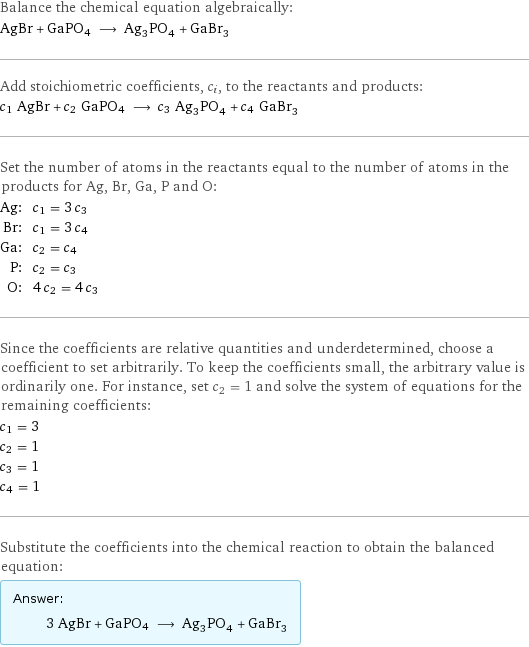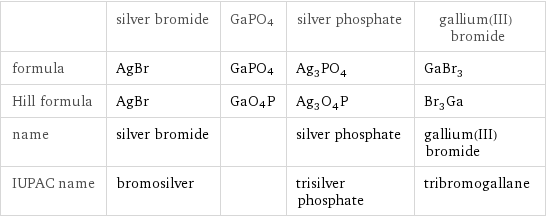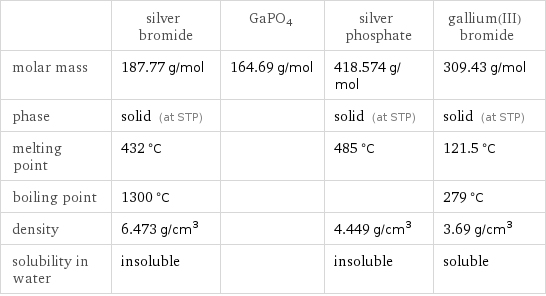Input interpretation

AgBr silver bromide + GaPO4 ⟶ Ag_3PO_4 silver phosphate + GaBr_3 gallium(III) bromide
Balanced equation

Balance the chemical equation algebraically: AgBr + GaPO4 ⟶ Ag_3PO_4 + GaBr_3 Add stoichiometric coefficients, c_i, to the reactants and products: c_1 AgBr + c_2 GaPO4 ⟶ c_3 Ag_3PO_4 + c_4 GaBr_3 Set the number of atoms in the reactants equal to the number of atoms in the products for Ag, Br, Ga, P and O: Ag: | c_1 = 3 c_3 Br: | c_1 = 3 c_4 Ga: | c_2 = c_4 P: | c_2 = c_3 O: | 4 c_2 = 4 c_3 Since the coefficients are relative quantities and underdetermined, choose a coefficient to set arbitrarily. To keep the coefficients small, the arbitrary value is ordinarily one. For instance, set c_2 = 1 and solve the system of equations for the remaining coefficients: c_1 = 3 c_2 = 1 c_3 = 1 c_4 = 1 Substitute the coefficients into the chemical reaction to obtain the balanced equation: Answer: | | 3 AgBr + GaPO4 ⟶ Ag_3PO_4 + GaBr_3
Structures

+ GaPO4 ⟶ +
Names

silver bromide + GaPO4 ⟶ silver phosphate + gallium(III) bromide
Equilibrium constant
![Construct the equilibrium constant, K, expression for: AgBr + GaPO4 ⟶ Ag_3PO_4 + GaBr_3 Plan: • Balance the chemical equation. • Determine the stoichiometric numbers. • Assemble the activity expression for each chemical species. • Use the activity expressions to build the equilibrium constant expression. Write the balanced chemical equation: 3 AgBr + GaPO4 ⟶ Ag_3PO_4 + GaBr_3 Assign stoichiometric numbers, ν_i, using the stoichiometric coefficients, c_i, from the balanced chemical equation in the following manner: ν_i = -c_i for reactants and ν_i = c_i for products: chemical species | c_i | ν_i AgBr | 3 | -3 GaPO4 | 1 | -1 Ag_3PO_4 | 1 | 1 GaBr_3 | 1 | 1 Assemble the activity expressions accounting for the state of matter and ν_i: chemical species | c_i | ν_i | activity expression AgBr | 3 | -3 | ([AgBr])^(-3) GaPO4 | 1 | -1 | ([GaPO4])^(-1) Ag_3PO_4 | 1 | 1 | [Ag3PO4] GaBr_3 | 1 | 1 | [GaBr3] The equilibrium constant symbol in the concentration basis is: K_c Mulitply the activity expressions to arrive at the K_c expression: Answer: | | K_c = ([AgBr])^(-3) ([GaPO4])^(-1) [Ag3PO4] [GaBr3] = ([Ag3PO4] [GaBr3])/(([AgBr])^3 [GaPO4])](../image_source/dc71da213c2c5ad8e2c2121d2c032f64.png)
Construct the equilibrium constant, K, expression for: AgBr + GaPO4 ⟶ Ag_3PO_4 + GaBr_3 Plan: • Balance the chemical equation. • Determine the stoichiometric numbers. • Assemble the activity expression for each chemical species. • Use the activity expressions to build the equilibrium constant expression. Write the balanced chemical equation: 3 AgBr + GaPO4 ⟶ Ag_3PO_4 + GaBr_3 Assign stoichiometric numbers, ν_i, using the stoichiometric coefficients, c_i, from the balanced chemical equation in the following manner: ν_i = -c_i for reactants and ν_i = c_i for products: chemical species | c_i | ν_i AgBr | 3 | -3 GaPO4 | 1 | -1 Ag_3PO_4 | 1 | 1 GaBr_3 | 1 | 1 Assemble the activity expressions accounting for the state of matter and ν_i: chemical species | c_i | ν_i | activity expression AgBr | 3 | -3 | ([AgBr])^(-3) GaPO4 | 1 | -1 | ([GaPO4])^(-1) Ag_3PO_4 | 1 | 1 | [Ag3PO4] GaBr_3 | 1 | 1 | [GaBr3] The equilibrium constant symbol in the concentration basis is: K_c Mulitply the activity expressions to arrive at the K_c expression: Answer: | | K_c = ([AgBr])^(-3) ([GaPO4])^(-1) [Ag3PO4] [GaBr3] = ([Ag3PO4] [GaBr3])/(([AgBr])^3 [GaPO4])
Rate of reaction
![Construct the rate of reaction expression for: AgBr + GaPO4 ⟶ Ag_3PO_4 + GaBr_3 Plan: • Balance the chemical equation. • Determine the stoichiometric numbers. • Assemble the rate term for each chemical species. • Write the rate of reaction expression. Write the balanced chemical equation: 3 AgBr + GaPO4 ⟶ Ag_3PO_4 + GaBr_3 Assign stoichiometric numbers, ν_i, using the stoichiometric coefficients, c_i, from the balanced chemical equation in the following manner: ν_i = -c_i for reactants and ν_i = c_i for products: chemical species | c_i | ν_i AgBr | 3 | -3 GaPO4 | 1 | -1 Ag_3PO_4 | 1 | 1 GaBr_3 | 1 | 1 The rate term for each chemical species, B_i, is 1/ν_i(Δ[B_i])/(Δt) where [B_i] is the amount concentration and t is time: chemical species | c_i | ν_i | rate term AgBr | 3 | -3 | -1/3 (Δ[AgBr])/(Δt) GaPO4 | 1 | -1 | -(Δ[GaPO4])/(Δt) Ag_3PO_4 | 1 | 1 | (Δ[Ag3PO4])/(Δt) GaBr_3 | 1 | 1 | (Δ[GaBr3])/(Δt) (for infinitesimal rate of change, replace Δ with d) Set the rate terms equal to each other to arrive at the rate expression: Answer: | | rate = -1/3 (Δ[AgBr])/(Δt) = -(Δ[GaPO4])/(Δt) = (Δ[Ag3PO4])/(Δt) = (Δ[GaBr3])/(Δt) (assuming constant volume and no accumulation of intermediates or side products)](../image_source/81a46d37bacc61f1f841eb08e786b60e.png)
Construct the rate of reaction expression for: AgBr + GaPO4 ⟶ Ag_3PO_4 + GaBr_3 Plan: • Balance the chemical equation. • Determine the stoichiometric numbers. • Assemble the rate term for each chemical species. • Write the rate of reaction expression. Write the balanced chemical equation: 3 AgBr + GaPO4 ⟶ Ag_3PO_4 + GaBr_3 Assign stoichiometric numbers, ν_i, using the stoichiometric coefficients, c_i, from the balanced chemical equation in the following manner: ν_i = -c_i for reactants and ν_i = c_i for products: chemical species | c_i | ν_i AgBr | 3 | -3 GaPO4 | 1 | -1 Ag_3PO_4 | 1 | 1 GaBr_3 | 1 | 1 The rate term for each chemical species, B_i, is 1/ν_i(Δ[B_i])/(Δt) where [B_i] is the amount concentration and t is time: chemical species | c_i | ν_i | rate term AgBr | 3 | -3 | -1/3 (Δ[AgBr])/(Δt) GaPO4 | 1 | -1 | -(Δ[GaPO4])/(Δt) Ag_3PO_4 | 1 | 1 | (Δ[Ag3PO4])/(Δt) GaBr_3 | 1 | 1 | (Δ[GaBr3])/(Δt) (for infinitesimal rate of change, replace Δ with d) Set the rate terms equal to each other to arrive at the rate expression: Answer: | | rate = -1/3 (Δ[AgBr])/(Δt) = -(Δ[GaPO4])/(Δt) = (Δ[Ag3PO4])/(Δt) = (Δ[GaBr3])/(Δt) (assuming constant volume and no accumulation of intermediates or side products)
Chemical names and formulas

| silver bromide | GaPO4 | silver phosphate | gallium(III) bromide formula | AgBr | GaPO4 | Ag_3PO_4 | GaBr_3 Hill formula | AgBr | GaO4P | Ag_3O_4P | Br_3Ga name | silver bromide | | silver phosphate | gallium(III) bromide IUPAC name | bromosilver | | trisilver phosphate | tribromogallane
Substance properties

| silver bromide | GaPO4 | silver phosphate | gallium(III) bromide molar mass | 187.77 g/mol | 164.69 g/mol | 418.574 g/mol | 309.43 g/mol phase | solid (at STP) | | solid (at STP) | solid (at STP) melting point | 432 °C | | 485 °C | 121.5 °C boiling point | 1300 °C | | | 279 °C density | 6.473 g/cm^3 | | 4.449 g/cm^3 | 3.69 g/cm^3 solubility in water | insoluble | | insoluble | soluble
Units
